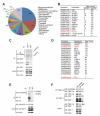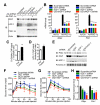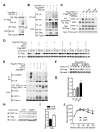O-GlcNAc transferase/host cell factor C1 complex regulates gluconeogenesis by modulating PGC-1α stability
- PMID: 22883232
- PMCID: PMC3480732
- DOI: 10.1016/j.cmet.2012.07.006
O-GlcNAc transferase/host cell factor C1 complex regulates gluconeogenesis by modulating PGC-1α stability
Abstract
A major cause of hyperglycemia in diabetic patients is inappropriate hepatic gluconeogenesis. PGC-1α is a master regulator of gluconeogenesis, and its activity is controlled by various posttranslational modifications. A small portion of glucose metabolizes through the hexosamine biosynthetic pathway, which leads to O-linked β-N-acetylglucosamine (O-GlcNAc) modification of cytoplasmic and nuclear proteins. Using a proteomic approach, we identified a broad variety of proteins associated with O-GlcNAc transferase (OGT), among which host cell factor C1 (HCF-1) is highly abundant. HCF-1 recruits OGT to O-GlcNAcylate PGC-1α, and O-GlcNAcylation facilitates the binding of the deubiquitinase BAP1, thus protecting PGC-1α from degradation and promoting gluconeogenesis. Glucose availability modulates gluconeogenesis through the regulation of PGC-1α O-GlcNAcylation and stability by the OGT/HCF-1 complex. Hepatic knockdown of OGT and HCF-1 improves glucose homeostasis in diabetic mice. These findings define the OGT/HCF-1 complex as a glucose sensor and key regulator of gluconeogenesis, shedding light on new strategies for treating diabetes.
Copyright © 2012 Elsevier Inc. All rights reserved.
Figures







Similar articles
-
A PGC-1alpha-O-GlcNAc transferase complex regulates FoxO transcription factor activity in response to glucose.J Biol Chem. 2009 Feb 20;284(8):5148-57. doi: 10.1074/jbc.M808890200. Epub 2008 Dec 22. J Biol Chem. 2009. PMID: 19103600 Free PMC article.
-
HCF-1 as a key modulator of OGT function and O-GlcNAcylation in the liver.Sci Rep. 2025 Aug 3;15(1):28328. doi: 10.1038/s41598-025-11813-1. Sci Rep. 2025. PMID: 40754593 Free PMC article.
-
Crosstalk between O-GlcNAcylation and proteolytic cleavage regulates the host cell factor-1 maturation pathway.Proc Natl Acad Sci U S A. 2011 Feb 15;108(7):2747-52. doi: 10.1073/pnas.1013822108. Epub 2011 Feb 1. Proc Natl Acad Sci U S A. 2011. PMID: 21285374 Free PMC article.
-
The Biochemistry of O-GlcNAc Transferase: Which Functions Make It Essential in Mammalian Cells?Annu Rev Biochem. 2016 Jun 2;85:631-57. doi: 10.1146/annurev-biochem-060713-035344. Annu Rev Biochem. 2016. PMID: 27294441 Review.
-
The making of a sweet modification: structure and function of O-GlcNAc transferase.J Biol Chem. 2014 Dec 12;289(50):34424-32. doi: 10.1074/jbc.R114.604405. Epub 2014 Oct 21. J Biol Chem. 2014. PMID: 25336649 Free PMC article. Review.
Cited by
-
O-GlcNAc signaling entrains the circadian clock by inhibiting BMAL1/CLOCK ubiquitination.Cell Metab. 2013 Feb 5;17(2):303-10. doi: 10.1016/j.cmet.2012.12.015. Cell Metab. 2013. PMID: 23395176 Free PMC article.
-
Hengshun Aromatic Vinegar Improves Glycolipid Metabolism in Type 2 Diabetes Mellitus via Regulating PGC-1α/PGC-1β Pathway.Front Pharmacol. 2021 Apr 26;12:641829. doi: 10.3389/fphar.2021.641829. eCollection 2021. Front Pharmacol. 2021. PMID: 33981226 Free PMC article.
-
O-GlcNAc: A Bittersweet Switch in Liver.Front Endocrinol (Lausanne). 2014 Dec 17;5:221. doi: 10.3389/fendo.2014.00221. eCollection 2014. Front Endocrinol (Lausanne). 2014. PMID: 25566193 Free PMC article. Review.
-
A Chemoenzymatic Method Based on Easily Accessible Enzymes for Profiling Protein O-GlcNAcylation.Anal Chem. 2020 Jul 21;92(14):9807-9814. doi: 10.1021/acs.analchem.0c01284. Epub 2020 Jul 7. Anal Chem. 2020. PMID: 32574038 Free PMC article.
-
Role of O-linked N-acetylglucosamine in the homeostasis of metabolic organs, and its potential links with diabetes and its complications.J Diabetes Investig. 2021 Feb;12(2):130-136. doi: 10.1111/jdi.13359. Epub 2020 Aug 25. J Diabetes Investig. 2021. PMID: 32654398 Free PMC article. Review.
References
-
- Capotosti F, Guernier S, Lammers F, Waridel P, Cai Y, Jin J, Conaway JW, Conaway RC, Herr W. O-GlcNAc Transferase Catalyzes Site-Specific Proteolysis of HCF-1. Cell. 2011;144:376–388. - PubMed
-
- Chikanishi T, Fujiki R, Hashiba W, Sekine H, Yokoyama A, Kato S. Glucose-induced expression of MIP-1 genes requires O-GlcNAc transferase in monocytes. Biochem Biophys Res Commun. 2010;394:865–870. - PubMed
Publication types
MeSH terms
Substances
Grants and funding
- R01 DK089098/DK/NIDDK NIH HHS/United States
- P41 RR011823/RR/NCRR NIH HHS/United States
- P30 AG021342/AG/NIA NIH HHS/United States
- P01 DK057751/DK/NIDDK NIH HHS/United States
- P30 DK045735/DK/NIDDK NIH HHS/United States
- P30-DK34989/DK/NIDDK NIH HHS/United States
- P30-DK045735/DK/NIDDK NIH HHS/United States
- P30 DK034989/DK/NIDDK NIH HHS/United States
- P01-DK057751/DK/NIDDK NIH HHS/United States
- P41 GM103533/GM/NIGMS NIH HHS/United States
- P30-AG021342/AG/NIA NIH HHS/United States
- R01-DK089098/DK/NIDDK NIH HHS/United States
- P41-RR011823/RR/NCRR NIH HHS/United States
LinkOut - more resources
Full Text Sources
Medical
Molecular Biology Databases
Miscellaneous

